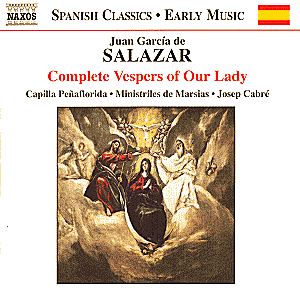Entrada: Regina Coeli (instrumental)
[1:31]
Invitatorio: Deus In ADJutorium Meum
- Domine Ad
AdJuvandum Me [0:51]
Antifona: Dum Esset [0:45]
Salmo 109: Dixit Dominus
[4:44]
Motete: Quae Es Ista [4:11]
Antifona: Laeva Ejus [0:35]
Motete: O Gloriosa Virginum
[3:08]
Antifona: Nigra Sum [0:42]
Salmo 121: Laetatus Sum [5:08]
Motete: Sub Tuum Praesidium
[3:04]
Da Pacem, Domine (instrumental)
[2:11]
Antifona: Jam Hiems [0:35]
Motete: Vidi Speciosam [4:07]
Antifona: Speciosa [0:33]
Salmo 147: Lauda Jersualem, Dominum
[4:44]
Veni Sponsa Christi (instrumental)
[1:35]
Himno: Ave Maris Stella [4:48]
Antifona: Sancta Maria, Seccurre
Miseris [3:42]
Cantico B.V.M.: Magnificat [6:19]
Salve Reina De Los Cielos (Salve
En Romance) [3:41]
Juan García
de Salazarís name may no longer be a
familiar one, but during the Baroque
era he was among the most well known
of Spanish composers of church music.
Exemplary of the polyphonic vocal music
that was popular in Spain, and quite
innovative for the region and time,
much of his music was still being used
in liturgical services throughout the
nineteenth century. We know that he
was writing liturgical music by the
age of 19, and that he served as maestro
de capilla for three different cathedrals
throughout his adult life. Therefore
it is appropriate that his work could
be collected together in a recording
such as this, to exhibit the music in
its original and intended format.
Even so, not enough
of his music is extant to recreate a
full liturgical service. Thus there
are organ selections included by other
Spanish composers living and writing
during the Baroque era. Also, because
of the tradition of performing instrumental
music during the liturgy, where none
of García de Salazarís exists,
the decision was made to transcribe
some of his vocal music for period instruments.
The result is an authentic recreation
of a vespers service that could easily
have been performed in Zamora Cathedral
in 1700.
In many ways de Salazarís
work reminds one of William Byrd, Palestrina,
or other composers of the late Renaissance.
This is partially because the works
of Bach and Haydn were more influential
in Northern Europe, and where it borrows
from its contemporaries, it borrows
more from Haydn. There is nothing in
the way of fugue writing. Of course,
interspersing plainchant throughout
the service also reminds the listener
of music far older than the 1600s. This
probably frames the entire collection
in an early-music context resulting
in the early music and Renaissance "feel"
amid the largely Baroque instrumentation.
This does not detract in any way from
what is actually produced. The music
itself is lovely.
The performances throughout
are quite good. The decision to put
them in their proper context, as a complete
vespers service, is intelligent and
audibly useful. Rather than a randomly
collected group of unrelated works,
this becomes a complete musical experience.
Vocally, the performers do a commendable
job. The melodies sound with absolute
purity. The chants flow mellifluously.
The solo work of Josep Cabré
lends a gravitas to the works that is
both absolutely in character and contrasts
well with the straight-toned chants.
The transcriptions
for instruments also leave little to
be desired. The Ministriles de Marias
(Marsayasís minstrels) are more than
simply competent. They perform both
their accompanying and featured roles
with an obvious expertise derived from
intimate knowledge of the genre. Also,
it is rare enough to find medieval and
Renaissance instruments in Baroque works,
but the shawm and dulcian are refreshing
additions to the aural tapestry. Additionally,
the string accompaniments provided by
Capilla Peñaflorida are similarly
outstanding.
Even the booklet is
well done, giving helpful explanations
of the works, the reasons for their
selection, and the entire text, both
in the original tongue and in English
translation.
It is evident that
a great deal of care has been put into
this album. It is well performed and
recorded throughout. García de
Salazarís work, while no longer familiar,
is very good. In summation, there is
little about this recording not to like.
One cannot help but recommend it.
Patrick Gary
see also review
by Johan
van Veen







